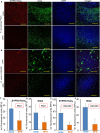A surfactant polymer dressing potentiates antimicrobial efficacy in biofilm disruption
- PMID: 29343818
- PMCID: PMC5772662
- DOI: 10.1038/s41598-018-19175-7
A surfactant polymer dressing potentiates antimicrobial efficacy in biofilm disruption
Abstract
A 100% water-soluble surfactant polymer dressing (SPD) that is bio-compatible and non-ionic has been reported to improve wound closure in preliminary clinical studies. The mechanism of action of SPD in wound healing remains unclear. Biofilm infection is a significant problem that hinders proper wound closure. The objective of this study was to characterize the mechanism of action of SPD inhibition of bacterial biofilm development. Static biofilms (48 h) of the primary wound pathogens Pseudomonas aeruginosa (PA01), Staphylococcus aureus (USA300) were grown on polycarbonate membranes and treated with SPD with and without antibiotics for an additional 24 h. The standard antibiotics - tobramycin (10 μg/ml) for PA01 and rifampicin (10 μg/ml) for USA300, were used in these studies. Following 24 h treatment with and without antibiotics, the biofilms were characterized using scanning electron microscopy (SEM) structural imaging, in vitro imaging system (IVIS) proliferation imaging, colony forming units (CFU), viability assay, quantitative PCR (qPCR) for virulence gene expression. Because SPD is a surfactant based dressing, it potentially has a direct effect on Gram negative bacteria such as Pseudomonas primarily due to the lipid-based outer membrane of the bacteria. SPD is a surfactant based dressing that has potent anti-biofilm properties directly or in synergy with antibiotics.
Conflict of interest statement
The authors declare that they have no competing interests.
Figures




Similar articles
-
A surfactant-based wound dressing can reduce bacterial biofilms in a porcine skin explant model.Int Wound J. 2017 Apr;14(2):408-413. doi: 10.1111/iwj.12619. Epub 2016 May 22. Int Wound J. 2017. PMID: 27212453 Free PMC article.
-
Efficacy of a surfactant-based wound dressing on biofilm control.Wound Repair Regen. 2017 Sep;25(5):767-773. doi: 10.1111/wrr.12581. Epub 2017 Oct 11. Wound Repair Regen. 2017. PMID: 28857343
-
A study on the ability of quaternary ammonium groups attached to a polyurethane foam wound dressing to inhibit bacterial attachment and biofilm formation.Wound Repair Regen. 2015 Jan-Feb;23(1):74-81. doi: 10.1111/wrr.12244. Epub 2015 Feb 13. Wound Repair Regen. 2015. PMID: 25469865
-
Restoring balance: biofilms and wound dressings.J Wound Care. 2018 Feb 2;27(2):102-113. doi: 10.12968/jowc.2018.27.2.102. J Wound Care. 2018. PMID: 29424642 Review.
-
Micro/nanosystems and biomaterials for controlled delivery of antimicrobial and anti-biofilm agents.Expert Opin Ther Pat. 2020 Dec;30(12):983-1000. doi: 10.1080/13543776.2020.1839415. Epub 2020 Nov 3. Expert Opin Ther Pat. 2020. PMID: 33078643 Review.
Cited by
-
Staphylococcus aureus Biofilm Destabilization by Tween-80 and Lung Surfactants to Overcome Biofilm-Imposed Drug Resistance.Appl Biochem Biotechnol. 2024 Mar;196(3):1558-1569. doi: 10.1007/s12010-023-04650-3. Epub 2023 Jul 11. Appl Biochem Biotechnol. 2024. PMID: 37432640
-
An injectable self-healing anesthetic glycolipid-based oleogel with antibiofilm and diabetic wound skin repair properties.Sci Rep. 2020 Oct 22;10(1):18017. doi: 10.1038/s41598-020-73708-7. Sci Rep. 2020. PMID: 33093507 Free PMC article.
-
Pseudomonas aeruginosa clinical isolates in Egypt: phenotypic, genotypic, and antibiofilm assessment of Pluronic F-127.BMC Microbiol. 2025 Apr 25;25(1):245. doi: 10.1186/s12866-025-03946-0. BMC Microbiol. 2025. PMID: 40281406 Free PMC article.
-
Correlative Imaging and super resolution microscopy studies reveal complexities in determining live-dead state of bacteria.Biofilm. 2025 Jul 3;10:100302. doi: 10.1016/j.bioflm.2025.100302. eCollection 2025 Dec. Biofilm. 2025. PMID: 40703962 Free PMC article.
-
Antibiofilm activity of Fmoc-phenylalanine against Gram-positive and Gram-negative bacterial biofilms.J Antibiot (Tokyo). 2021 Jun;74(6):407-416. doi: 10.1038/s41429-021-00409-2. Epub 2021 Feb 26. J Antibiot (Tokyo). 2021. PMID: 33637856
References
Publication types
MeSH terms
Substances
Grants and funding
LinkOut - more resources
Full Text Sources
Other Literature Sources

